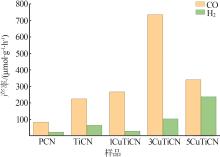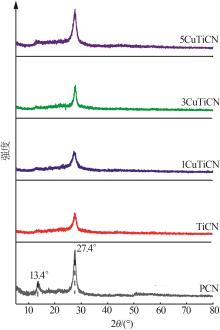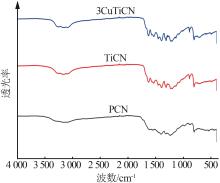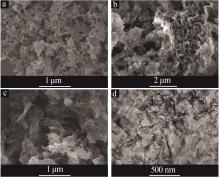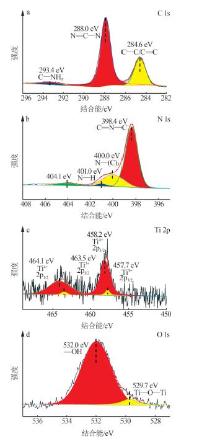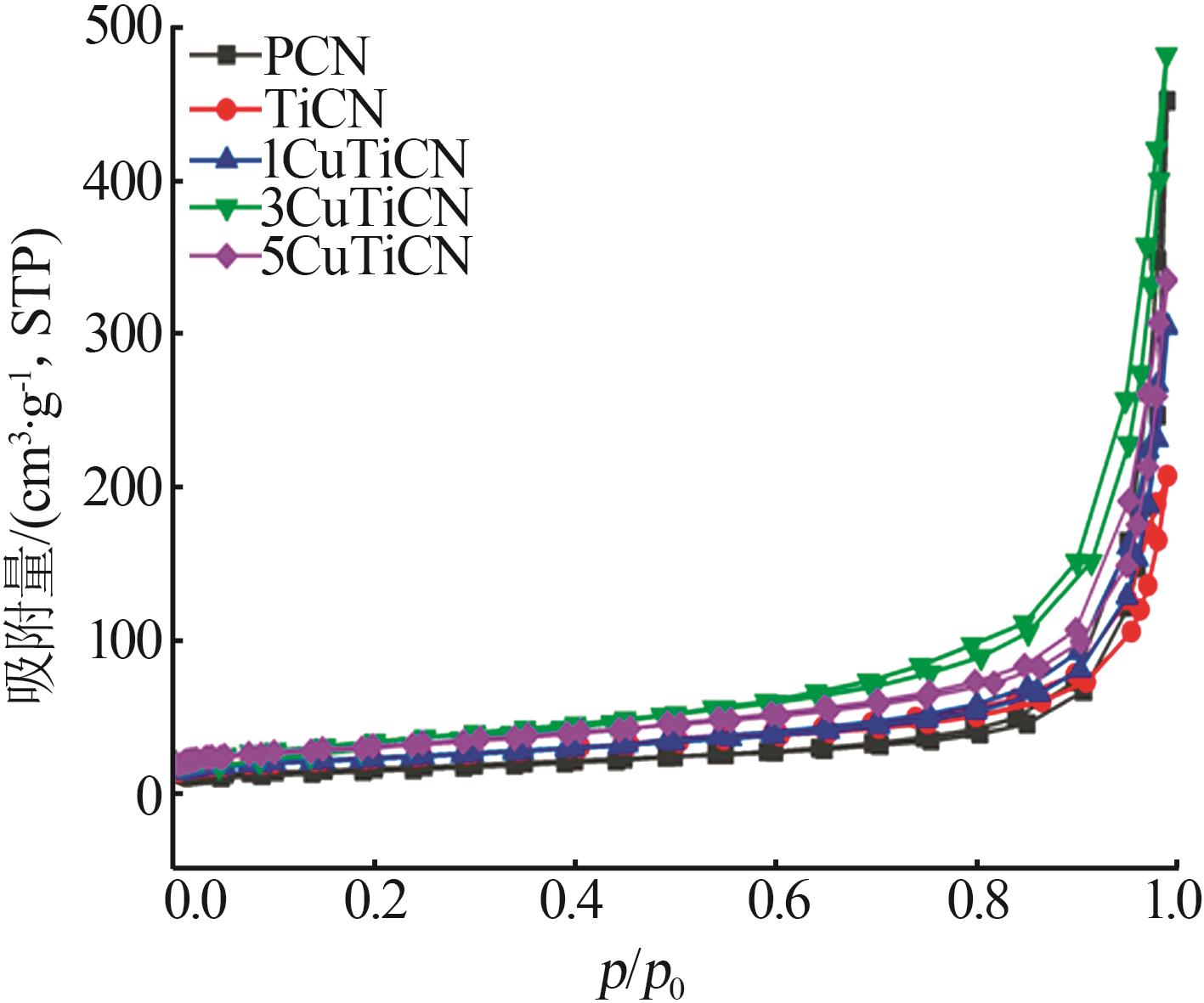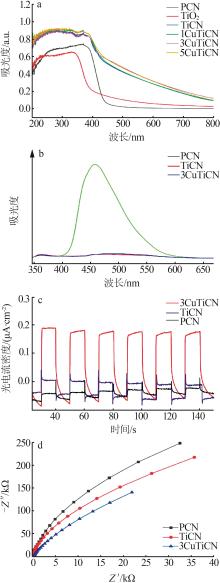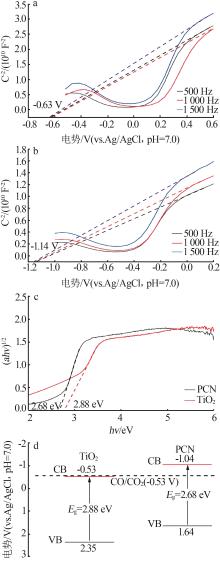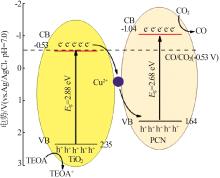Inorganic Chemicals Industry ›› 2023, Vol. 55 ›› Issue (8): 21-27.doi: 10.19964/j.issn.1006-4990.2023-0310
• Application of novel inorganic materials in photocatalysis and electrocatalysis • Previous Articles Next Articles
Study on photocatalytic CO2 reduction performance of Cu-doped TiO2/PCN heterojunction
ZHAO Yan( ), HAO Xuewei, SHI Hainan, LI Jiahui, LI Keyan(
), HAO Xuewei, SHI Hainan, LI Jiahui, LI Keyan( ), GUO Xinwen(
), GUO Xinwen( )
)
- State Key Laboratory of Fine Chemicals,Frontier Science Center for Smart Materials,School of ChemicalEngineering,Dalian University of Technology,Dalian 116024,China
-
Received:2023-06-08Online:2023-08-10Published:2023-08-25 -
Contact:LI Keyan, GUO Xinwen E-mail:1798161962@qq.com;keyanli@dlut.edu.cn;guoxw@dlut.edu.cn
CLC Number:
Cite this article
ZHAO Yan, HAO Xuewei, SHI Hainan, LI Jiahui, LI Keyan, GUO Xinwen. Study on photocatalytic CO2 reduction performance of Cu-doped TiO2/PCN heterojunction[J]. Inorganic Chemicals Industry, 2023, 55(8): 21-27.
share this article
| 1 | 邵斌,孙哲毅,章云,等.二氧化碳转化为合成气及高附加值产品的研究进展[J].化工进展,2022,41(3):1136-1151. |
| SHAO Bin, SUN Zheyi, ZHANG Yun,et al.Recent progresses in CO2 to syngas and high value-added products[J].Chemical Industry and Engineering Progress,2022,41(3):1136-1151. | |
| 2 | DAS S, PÉREZ-RAMÍREZ J, GONG Jinlong,et al.Core-shell st-ructured catalysts for thermocatalytic,photocatalytic,and electrocatalytic conversion of CO2 [J].Chemical Society Reviews,2020,49(10):2937-3004. |
| 3 | GAO Dunfeng, LI Wanjun, WANG Hanyu,et al.Heterogeneous catalysis for CO2 conversion into chemicals and fuels[J].Transactions of Tianjin University,2022,28(4):245-264. |
| 4 | 唐兰勤,贾茵,朱志尚,等.光催化二氧化碳还原研究进展[J].物理学进展,2021,41(6):254-263. |
| TANG Lanqin, JIA Yin, ZHU Zhishang,et al.Development of functional materials for photocatalytic reduction of CO2 [J].Progress in Physics,2021,41(6):254-263. | |
| 5 | LIN Huiwen, LUO Shunqin, ZHANG Huabin,et al.Toward solar-driven carbon recycling[J].Joule,2022,6(2):294-314. |
| 6 | WANG Xinchen, MAEDA K, THOMAS A,et al.A metal-free polymeric photocatalyst for hydrogen production from water under visible light[J].Nature Materials,2009,8(1):76-80. |
| 7 | 班昌胜,李军,金央,等.超分子前体制备g-C3N4/g-C3N4同质结及光催化性能研究[J].无机盐工业,2022,54(3):125-131. |
| BAN Changsheng, LI Jun, JIN Yang,et al.Study on preparation of g-C3N4/g-C3N4 homojunction by supramolecular precursor and its photocatalytic property[J].Inorganic Chemicals Industry,2022,54(3):125-131. | |
| 8 | LUO Lei, ZHANG Anfeng, JANIK M J,et al.Facile fabrication of metal-free urchin-like g-C3N4 with superior photocatalytic activi- ty[J].RSC Advances,2016,6(97):94496-94501. |
| 9 | ONG W J, TAN L L, NG Y H,et al.Graphitic carbon nitride(g-C3N4)-based photocatalysts for artificial photosynthesis and environmental remediation:Are we a step closer to achieving sustainability?[J].Chemical Reviews,2016,116(12):7159-7329. |
| 10 | 李佳慧,李克艳,宋春山,等.聚合氮化碳的制备、改性及光催化还原二氧化碳性能研究[J].无机盐工业,2021,53(12):21-28. |
| LI Jiahui, LI Keyan, SONG Chunshan,et al.Study on preparation,modification and carbon dioxide photocatalytic reduction performance of polymeric carbon nitride[J].Inorganic Chemicals Industry,2021,53(12):21-28. | |
| 11 | YANG Xiaohang, GUO Zilong, ZHANG Xiaoyu,et al.The effect of indium doping on the hydrogen evolution performance of g-C3N4 based photocatalysts[J].New Journal of Chemistry,2021,45(2):544-550. |
| 12 | YANG Xi, TIAN Zhen, CHEN Yufang,et al. In situ synthesis of 2D ultrathin cobalt doped g-C3N4 nanosheets enhances photocatalytic performance by accelerating charge transfer[J].Journal of Alloys and Compounds,2021,859:157754. |
| 13 | JIANG Longbo, YANG Jinjuan, YUAN Xingzhong,et al.Defect engineering in polymeric carbon nitride photocatalyst:Synthesis,properties and characterizations[J].Advances in Colloid and Interface Science,2021,296:102523. |
| 14 | LIU Tongyao, HAO Lin, BAI Liqi,et al.Z-scheme junction Bi2O2(NO3)(OH)/g-C3N4 for promoting CO2 photoreduction[J].Chemical Engineering Journal,2022,429:132268. |
| 15 | SHI Hainan, LONG Saran, HU Shen,et al.Interfacial charge transfer in 0D/2D defect-rich heterostructures for efficient solar-driven CO2 reduction[J].Applied Catalysis B:Environmental,2019,245:760-769. |
| 16 | ZHAO Shuangchao, LI Keyan, DU Jun,et al.Facile construction of a hollow In2S3/polymeric carbon nitride heterojunction for efficient visible-light-driven CO2 reduction[J].ACS Sustainable Chemistry & Engineering,2021,9(17):5942-5951. |
| 17 | JIANG Zhifeng, WAN Weiming, LI Huaming,et al.A hierarchical Z-scheme α-Fe2O3/g-C3N4 hybrid for enhanced photocatalytic CO2 reduction[J].Advanced Materials,2018,30(10):1706108. |
| 18 | SHI Hainan, DU Jun, HOU Jungang,et al.Solar-driven CO2 conversion over Co2+ doped 0D/2D TiO2/g-C3N4 heterostructure:Insights into the role of Co2+ and cocatalyst[J].Journal of CO2 Utilization,2020,38:16-23. |
| 19 | KHAN M A, MUTAHIR S, WANG Fengyun,et al.Facile one-step economical methodology of metal free g-C3N4 synthesis with remarkable photocatalytic performance under visible light to degrade trans-resveratrol[J].Journal of Hazardous Materials,2019,367:293-303. |
| 20 | ZHONG Jiapeng, HUANG Jiaxing, LIU Yang,et al.Construction of double-functionalized g-C3N4 heterojunction structure via optimized charge transfer for the synergistically enhanced photocatalytic degradation of sulfonamides and H2O2 production[J].Journal of Hazardous Materials,2022,422:126868. |
| 21 | WANG Jian, YANG Zhuang, YAO Wenqing,et al.Defects modified in the exfoliation of g-C3N4 nanosheets via a self-assembly process for improved hydrogen evolution performance[J].Applied Catalysis B:Environmental,2018,238:629-637. |
| 22 | LEI Juying, CHEN Bin, ZHOU Liang,et al.Efficient degradation of antibiotics in different water matrices through the photocatalysis of inverse opal K-g-C3N4:Insights into mechanism and assessment of antibacterial activity[J].Chemical Engineering Journal,2020,400:125902. |
| 23 | DU Jun, SHI Hainan, WU Jiaming,et al.Interface and defect engineering of a hollow TiO2@ZnIn2S4 heterojunction for highly enhanced CO2 photoreduction activity[J].ACS Sustainable Chemistry & Engineering,2023,11(6):2531-2540. |
| 24 | LI Xiaochun, WANG Jiawen, XIA Jiawei,et al.One-pot synthesis of CoS2 merged in polymeric carbon nitride films for photoelectrochemical water splitting[J].ChemSusChem,2022,15(8):e202200330. |
| [1] | TANG Bei. Preparation of ZnO/g-C3N4 heterojunction photocatalytic material and its degradation of pyridine [J]. Inorganic Chemicals Industry, 2024, 56(4): 133-142. |
| [2] | HUANG Jianan, LU Xiaoyu, WANG Mitang. Effect of Ba-La co-doping on degradation of methylene blue dye by TaON [J]. Inorganic Chemicals Industry, 2024, 56(2): 146-151. |
| [3] | YANG Bo, LIANG Zhiyan, LIU Wenyuan, CAO Jiazhen, LIU Xinyue, XING Mingyang. Research progress of application of molybdenum-based catalytic materials for water pollution control [J]. Inorganic Chemicals Industry, 2023, 55(8): 1-12. |
| [4] | YU Hongchao, ZHANG Mengmeng, JIN Tianxiang. Research progress of microstructure and crystal surface effect of Ag3PO4 photocatalysts [J]. Inorganic Chemicals Industry, 2023, 55(8): 13-20. |
| [5] | SUN Haijie, CHENG Yuan, TIAN Yuan, LIU Hongyan, CHEN Zhihao. Preparation of BiOI/g-C3N4 catalyst and its photocatalytic degradation performance of Rhodamine B [J]. Inorganic Chemicals Industry, 2023, 55(8): 36-44. |
| [6] | SONG Zhijia, WANG Suisui, KUANG Qin. Hollow Cu-doped TiO2 for enhancing photocatalytic CO2 reduction performance [J]. Inorganic Chemicals Industry, 2023, 55(8): 45-50. |
| [7] | LAN Yinghua, CHEN Yanmei, MA Ruixiao, ZHANG Yanhui. Preparation and photocatalytic performance of Ce-Ti oxide-attapulgite composites [J]. Inorganic Chemicals Industry, 2023, 55(4): 133-140. |
| [8] | CHEN Zhangxu, FU Minglian, ZHU Danchen, ZHENG Bingyun. Preparation of carbon/graphite carbon nitride composites and their methylene blue removal performance [J]. Inorganic Chemicals Industry, 2023, 55(3): 134-139. |
| [9] | QIU Xiaokui, ZHANG Ruofan, WANG Xiaoyan, WANG Hailong, ZHANG Qixue, WAN Chao, XU Lixin. Research on bamboo shavings carbon supported ruthenium catalysts for hydrogen generation from photocatalytic hydrolysis of ammonia borane [J]. Inorganic Chemicals Industry, 2023, 55(10): 153-158. |
| [10] | ZHANG Zhe,LIAO Mingyu,CHEN Ming,YU Shanshan,ZHOU Kangdi,LI Jiachun,ZHANG Linfeng,WU Huadong,GUO Jia. Application of CeO2-ZnO/KIT-6 catalyst in photocatalytic adsorption desulfurization [J]. Inorganic Chemicals Industry, 2022, 54(9): 143-149. |
| [11] | TONG Haijuan,LI Siqi,FAN Fangfang,ZUO Weiyuan,SHI Bingfang. Facile synthesis of bismuth oxychloride and its photocatalytic degradation performance of p-nitrophenol [J]. Inorganic Chemicals Industry, 2022, 54(9): 157-162. |
| [12] | YANG Wenbo,WU Pan,HE Jian,LIU Changjun,JIANG Wei. Study on effect of heating rate on structure-activity of g-C3N4 photocatalyst by pyrolysis of urea [J]. Inorganic Chemicals Industry, 2022, 54(4): 169-174. |
| [13] | LIANG Fang,SHI Fanian. Research progress on synthesis of bismuth based bimetallic photocatalyst and degradation of organic pollutants [J]. Inorganic Chemicals Industry, 2022, 54(4): 61-68. |
| [14] | BAN Changsheng,LI Jun,JIN Yang,CHEN Ming,ZUO Longtao. Study on preparation of g-C3N4/g-C3N4 homojunction by supramolecular precursor and its photocatalytic property [J]. Inorganic Chemicals Industry, 2022, 54(3): 125-131. |
| [15] | CHEN Jianjun,QIAO Yan,LIU Zixian,PENG Huanhuan,SONG Jialin,GAO Yan,LI Yongyu. Preparation of Au-supported porous g-C3N4 nanosheets for photocatalytic H2 evolution performance under visible-light [J]. Inorganic Chemicals Industry, 2022, 54(3): 132-136. |
| Viewed | ||||||
|
Full text |
|
|||||
|
Abstract |
|
|||||
|
||


